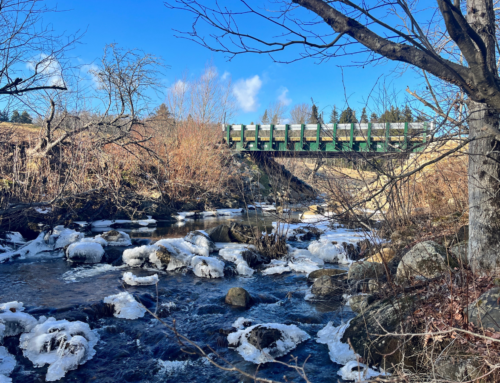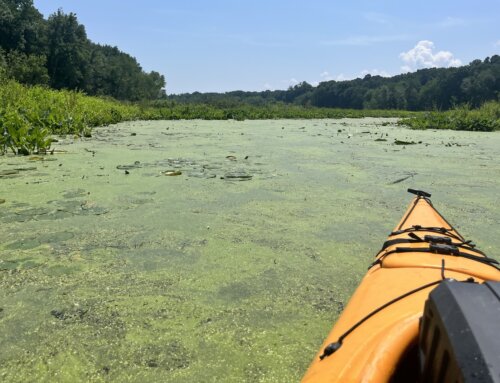February 10, 2010. Greenfield, MA. The Connecticut River Watershed Council today joined in the call for the shut down of the Vermont Yankee nuclear plant while the source of a spreading plume of radioactive tritium leaching into groundwater and the Connecticut River remains undiscovered. CRC’s announcement comes in the wake of the February 5th announcement by a group of Vermont legislators including Senate President Peter Shumlin and nearly all the state representatives from Windham County, home of the Vermont Yankee nuclear plant, that called upon Entergy Nuclear to cease operations at its facility until the source of the radioactive leaks can be pinpointed and the public’s safety assured. Tritium levels at four times the federal drinking water standard have been registered in on-site tests–just shy of the highest levels ever recorded nationally. The Vermont legislators cited their mandate to safeguard the public trust regarding groundwater and drinking water in taking their action.
The Connecticut River Watershed Council is also calling on Entergy for a full public accounting of all chemicals, radioactive material, and pollution entering the Connecticut River at its Vermont Yankee Nuclear Plant. “Radioactive tritium is just Entergy Vermont Yankee’s latest insult to the Connecticut River and all of us that enjoy fishing, boating and swimming in it. We believe people have a right to know what else is entering the river—whether from the groundwater plume, underground pipes, or the thermal pollution Entergy feeds into the Connecticut at Vernon.” said Chelsea Gwyther, Connecticut River Watershed Council Executive Director. The Connecticut River Watershed Council appealed to the Vermont Supreme Court Entergy Vermont Yankee’s thermal discharge permit which allows the nuclear power plant to increase the temperature of the Connecticut River by up to 13 degrees in the winter and up to 6 degrees in the summer. The thermal impact has been shown to extend up to 50 miles down to the Holyoke dam and coincides with a 99% drop in the American shad population at the Vernon pool according to the conservation group.
The source of the tritium leaks has yet to be pinpointed at the riverside nuclear plant. But the reach of the groundwater contamination has continued to widen as new testing has been undertaken. One new well just 100 feet south of where the original leak was detected showed tritium levels at 775,000 picocuries–3-1/2 times the federal safe drinking water standard, and the second highest level ever reported at a US nuclear plant . New disclosures also reveal that cobalt-60 at 13,000 picocuries per liter, and zinc-65 at 300 picocuries per liter—both hundreds times the federal drinking water standards, have been documented where the contamination was first discovered.
“It is flabbergasting to hear Entergy describe a plume of tritium leachate on the lip of the Connecticut River as benign. What goes into the river is hardly irrelevant to community health issues.” As news of the leaks came in CRC’s Vermont-New Hampshire River Steward David Deen, began requesting detailed information and disclosure from Entergy, the NRC, and the Vermont Department of Public Health, who has been issuing updates on the Yankee situation. The Council’s purview includes the protection of the watershed’s drinking water, groundwater, and surface waters of basin rivers and streams.
Deen, of Westminster, VT, is also a state representative and chair of the VT House Committee on Fish, Wildlife, and Water Resources. The Committee has scheduled weekly meetings with Vermont health officials to stay abreast of developments. VT Health Commissioner Wendy Davis has been coming before Deen’s committee to answer the many questions and requests for information arising from the radioactive groundwater plume. Dr. William Irwin, Radiological Health Chief at the Vermont Department of Health has also appeared to take information requests.
An onsite, radiological sampling team has now been formed, including members of the Agency of Natural Resources, Agency of Agriculture, and the Dept. of Health. Once representatives pass security background checks they expect to be part of the public oversight as testing continues. Deen notes that the Dept. of Health Commissioner is closely monitoring developments for any immediate threats to public, and does have the authority to request a plant shutdown as part of exercising “prudent caution.”
Meanwhile, the Watershed Council has gone ahead with its own requests for specific information about the contaminated groundwater plume at Yankee. There are some 30 existing test wells at Yankee, with another 11 wells slated to be drilled. Queries and information requests from the Council have also included detailed geomorphological maps of the contours and known groundwater flow at the Yankee site, as well as requests for information on the private and public sector individuals chosen to work on the contamination issue, “We just want to be sure that the most highly-qualified, independent people are in there doing this public oversight work,” said David Deen.
In keeping with their water protection mandate, the Council will be issuing updates and listing the latest news and information resources on its website: ctriver.org.
# # #
Contact: David Deen, VT/NH River Steward ddeen@ctriver.org
Chelsea Gwyther, Executive Director (413) 658-8552 cell cgwyther@ctriver.org







